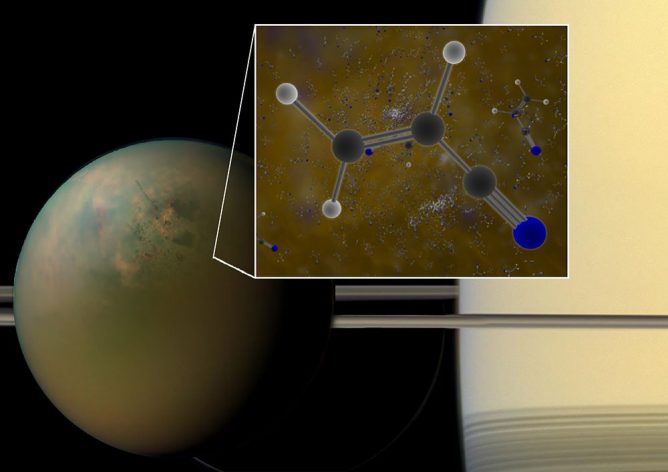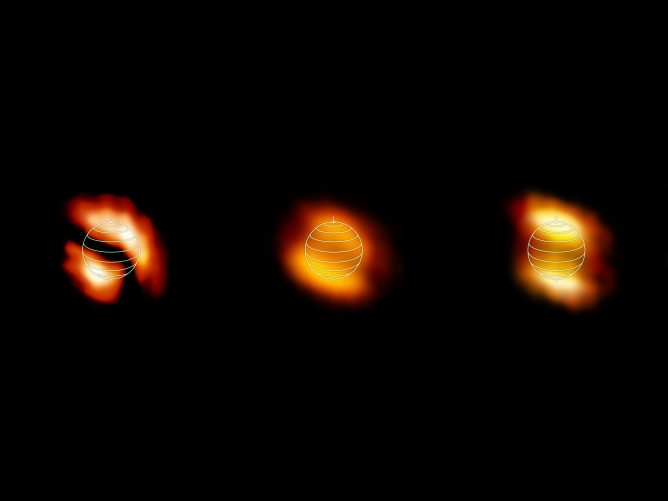Planetary scientists using the Atacama Large Millimeter/submillimeter Array (ALMA) revealed the secrets of the atmosphere of Titan, the largest moon of Saturn. The team found a chemical footprint in Titan’s atmosphere indicating that cosmic rays coming from outside the Solar System affect the chemical reactions involved in the formation of nitrogen-bearing organic molecules. This is the first observational confirmation of such processes, and impacts the understanding of the intriguing environment of Titan.

Optical image of Titan taken by NASA Cassini spacecraft.
Credit: NASA/JPL-Caltech/Space Science Institute
Titan is attracting much interest because of its unique atmosphere with a number of organic molecules that form a pre-biotic environment.
Takahiro Iino, a scientist at the University of Tokyo, and his team used ALMA to reveal the chemical processes in Titan’s atmosphere. They found faint but firm signals of acetonitrile (CH3CN) and its rare isotopomer CH3C15N in the ALMA data.

ALMA spectra of CH3CN and CH3C15N Titan’s atmosphere. Dotted vertical lines indicate the frequency of emission lines of two molecules predicted by a theoretical model.
Credit: Iino et al. (The University of Tokyo)
“We found that the abundance of 14N in acetonitrile is higher than those in other nitrogen bearing species such as HCN and HC3N,” says Iino. “It well matches the recent computer simulation of chemical processes with high energy cosmic rays.”
There are two important players in the chemical processes of the atmosphere;
ultraviolet (UV) light from the Sun and cosmic rays coming from outside the Solar System. In the upper atmosphere, UV light selectively destroys nitrogen molecules containing 15N because the UV light with the specific wavelength that interacts with 14N14N is easily absorbed at that altitude. Thus, nitrogen-bearing species produced at that altitude tend to exhibit a high 15N abundance. On the other hand, cosmic rays penetrate deeper and interact with nitrogen molecules containing 14N. As a result, there is a difference in the abundance of molecules with 14N and 15N. The team revealed that acetonitrile in the stratosphere is more abundant in 14N than those of other previously measured nitrogen-bearing molecules.
“We suppose that galactic cosmic rays play an important role in the atmospheres of other solar system bodies,” says Hideo Sagawa, an associate professor at Kyoto Sangyo University and a member of the research team. “The process could be universal, so understanding the role of cosmic rays in Titan is crucial in overall planetary science.”
Titan is one of the most popular objects in ALMA observations. The data obtained with ALMA needs to be calibrated to remove fluctuations due to variations of on-site weather and mechanical glitches. For referencing, the observatory staff often points the telescope at bright sources, such as Titan, from time to time in science observations. Therefore, a large amount of Titan data is stored in the ALMA Science Archive. Iino and his team have dug into the archive and re-analyzed the Titan data and found subtle fingerprints of very tiny amounts of CH3C15N.
Paper and the research team
These observation results are published as T. Iino et al. “14N/15N isotopic ratio in CH3CN of Titan’s atmosphere measured with ALMA” in the Astrophysical Journal published on February 2019.
The research team members are:
Takahiro Iino (The University of Tokyo), Hideo Sagawa (Kyoto Sangyo University) and Takashi Tsukagoshi (National Astronomical Observatory of Japan).
This research was supported by the JSPS KAKENHI (No. 17K14420 and 19K14782), the Telecommunication Advancement Foundation, and the Astrobiology Center, National Institutes of Natural Sciences.
The Atacama Large Millimeter/submillimeter Array (ALMA), an international astronomy facility, is a partnership of the European Organisation for Astronomical Research in the Southern Hemisphere (ESO), the U.S. National Science Foundation (NSF) and the National Institutes of Natural Sciences (NINS) of Japan in cooperation with the Republic of Chile. ALMA is funded by ESO on behalf of its Member States, by NSF in cooperation with the National Research Council of Canada (NRC) and the Ministry of Science and Technology (MOST) and by NINS in cooperation with the Academia Sinica (AS) in Taiwan and the Korea Astronomy and Space Science Institute (KASI). ALMA construction and operations are led by ESO on behalf of its Member States; by the National Radio Astronomy Observatory (NRAO), managed by Associated Universities, Inc. (AUI), on behalf of North America; and by the National Astronomical Observatory of Japan (NAOJ) on behalf of East Asia. The Joint ALMA Observatory (JAO) provides the unified leadership and management of the construction, commissioning and operation of ALMA.









